We Tried It: Apple's Vision Pro Headset, a Brave New World for Computing
I took two test drives on the tech giant's just-launched, $3,499 futuristic 'spatial computing' headset — and my mind was seriously blown

Courtesy of Apple
Here’s a confession: For the past seven months I’ve been ever-so-slightly obsessed with a pixelated, virtual butterfly. More on that later.
This whole butterfly thing started last June when I traveled to Apple’s headquarters in Cupertino, Calif. I’d been invited to test drive the new Vision Pro, a wearable headset that blends the physical world with a stunningly lush digital universe projected onto two postage stamp-sized displays with higher resolution than a 4K TV.
Vision Pro is Apple’s first foray into what company CEO Tim Cook calls “spatial computing,” which the tech giant hopes will transform how we work on everyday productivity tasks, communicate with each other and enjoy movies, games and memories—in the form of videos and photos—in a completely new way.

Courtesy of Apple
To describe my experience with this device as mind-blowing pretty much nails it—but it still comes up woefully short.
The Vision Pro looks like a pair of old-school ski goggles, weighs about a pound and a half, and is loaded up with 23 sensors, including a dozen cameras and six mics that track eye movements, hand gestures and voice while also sensing objects located around you.
Images are streamed onto the displays eight times faster than a human eye can blink, according ot Apple. The strap that holds the device on your head contains an array of speakers that deliver sound (which they call spatial audio) that makes whatever you’re hearing match the acoustics of the virtual environment in which you're immersed.
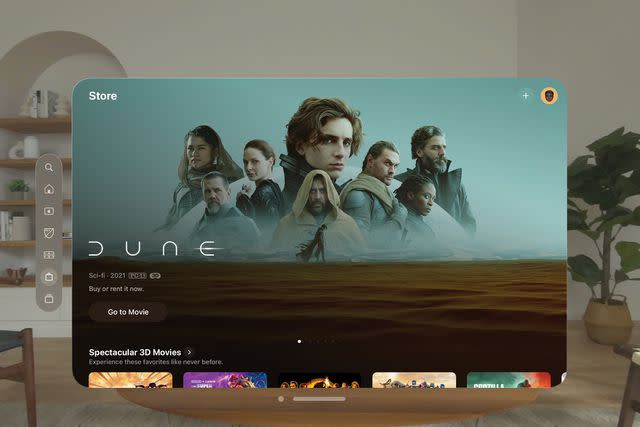
Courtesy of Apple
To be honest, I wasn’t expecting much when I got my first chance to try it out. Over the years, I’ve strapped a few other of these headsets onto my noggin — and each time, I came away nauseous, headachy, and underwhelmed. If this was the future of computing, I wasn't impressed.
But from the moment, I slipped on Apple’s new device and found myself staring into its two tiny displays filled with 23 million pixels, I was soon fighting a losing battle to keep my mouth from hanging open and uttering, “Oh wow!. . . Whoa!. . . Ohhh!. . . No way!”
I knew that none of images being splashed in front of my eyes were actual flesh-and-blood reality, but after a few seconds I didn’t care. I felt myself transported into whatever I was looking at. I was having a bona fide experience that was richer and light years beyond what it feels like to stare at and interact with files, words and images on my MacBook Air.
Related: Everything to Know About the iPhone 15, Including New Features and Price Changes
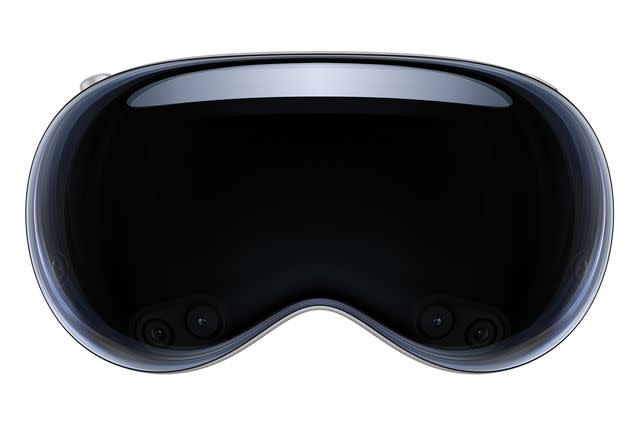
Courtesy of Apple
During my initial hands-on road-test with the Vision Pro — which required Apple to spend half an hour recreating my glasses prescription within the device, then properly securing it to my face to ensure no light was seeping in, I pushed a button called the Digital Crown on the top right of the goggles. The Vision Pro quickly came to life.
Within seconds, a grid of circular app icons was floating in the middle of the room. (Apple says over one million apps can work with the device and more than 600 apps have specifically been designed for Apple’s visionOS.)
To choose a specific app, I simply looked at it, pinched my thumb and index finger together and it opened. Holding my pinched fingers together and moving them up or down allowed me to scroll through the contents. Navigating with my eyes, hands and voice was incredibly intuitive.
Because I spend so many of my waking hours hammering away on my keyboard for work, I was jonesing to experience what that would be like using the Vision Pro. Creating a document — which I could enlarge to the size of a Mini Cooper and move around to any location in the room with my hands — did have a certain Minority Report feel to it. And staring at the foot-high words that I typed on the virtual keyboard (you can also connect a Bluetooth keyboard) was viscerally satisfying .
By twisting the Digital Crown, the room I was seated in dissolved. Suddenly I was standing next to a pristine alpine lake near the base of Oregon's Mt. Hood. Insects buzzed all around me as light rain splashed onto the surface of the lake. Looking around, I could see clouds drifting by in the blue sky and my feet were planted firmly in dirt. Behind me were towering fir trees.
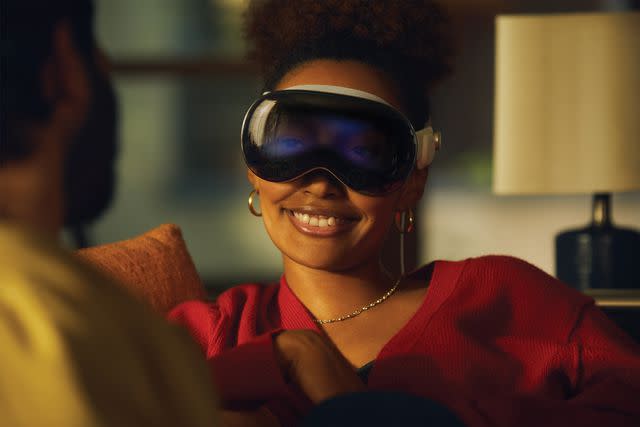
Courtesy of Apple
Making a video call on the device with FaceTime was even trippier. The Vision Pro cameras created my virtual 3-D doppelgänger — known as a Persona — that was displayed to the Apple rep I was chatting with on another part of the campus.
Thinking about using the headset in the room with others? In an effort to keep users from being isolated from those around them, the device also projects a digital representation of your eyes on front of the goggles, so those around you know when you are looking at them (vs. browsing the web).
You can also create your own 3-D movies, known as “spatial videos," by activating a camera using a button on the left side of the headset;These videos are unlike anything I’ve ever seen before and after a few seconds I was almost convinced that I'd been teleported back in time to the exact moment when that scene had been captured.
Even more awe-inspiring? Watching videos on the massive screen projected in front of me. At some point, I found myself immersed in the Encounter Dinosaurs app and standing in a lava field as a massive dino wandered about in front of me. Before long it appeared to emerge out of the confines of the screen and lumber toward me as the ground beneath my feet seemed to shake. My brain and gut told me it was all fake, but it was still a tad unnerving.
Related: Apple AirTag Helps Dog Reunite with Owner After Pet Is Swept Away by California Floodwaters
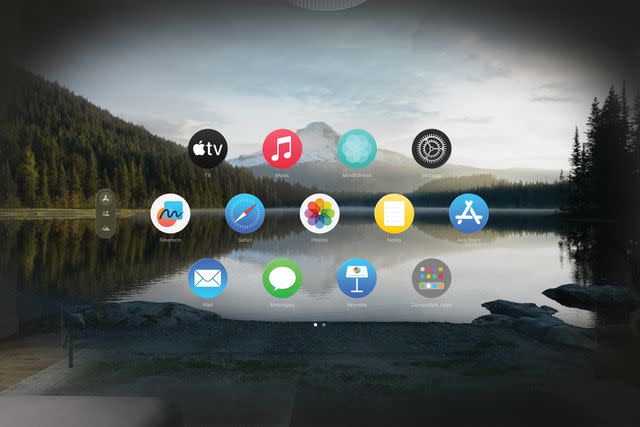
Courtesy of Apple
Then I spotted the virtual butterfly. It was flapping around in the distance, oblivious to the massive creatures nearby. At some point I stuck my hand out and watched it slowly land on my finger. And that’s when it happened. The moment its six spindly legs made contact with my finger, I could literally feel it touching my skin. The experience was gloriously perplexing and in the months that followed I convinced myself that I must have somehow imagined the whole thing.
Three weeks ago I was invited back to Apple’s L.A. headquarters to get some more time with the Vision Pro—and all I could think about was that damn butterfly. After putting the device through its paces and checking out some of the latest tweaks and new content, I asked my handlers if I could have one last encounter with their virtual winged insect. And sure enough, the moment it alighted upon my finger, it happened again. I could feel it.
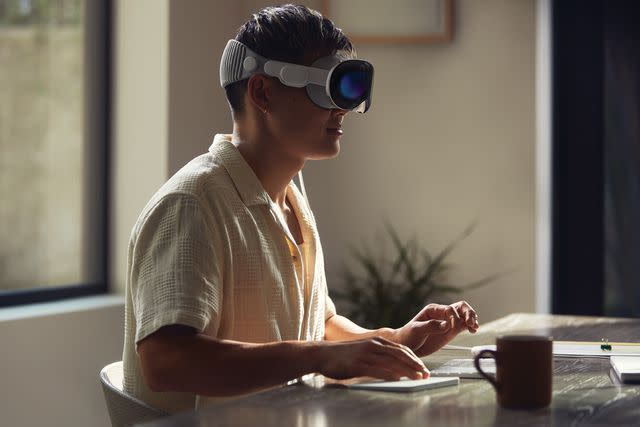
Courtesy of Apple
And that’s when I realized that, of course, I was imagining the whole experience. That’s how powerful the Vision Pro is at re-creating the reality of meatspace (a.k.a the physical world). It serves up a jaw-droppingly realistic artificial world and my brain — doing what my brain always does — just filled in the gaps.
What my brain can't do is envision where the Vision Pro and the technology behind it will lead us — but I’m more than happy to buckle up and take the ride. In the meantime, I’ll be outside, with my index finger boldly outstretched, searching for butterflies.
For more People news, make sure to sign up for our newsletter!
Read the original article on People.

